Cheap seats to smaller cities: good news for local tourism receipts? Evidence from Italy
Titolo Rivista RIV Rassegna Italiana di Valutazione
Autori/Curatori Andrea Alivernini, Alessio D'Ignazio, Andrea Migliardi
Anno di pubblicazione 2016 Fascicolo 2015/62 Lingua Inglese
Numero pagine 21 P. 9-29 Dimensione file 542 KB
DOI 10.3280/RIV2015-062003
Il DOI è il codice a barre della proprietà intellettuale: per saperne di più
clicca qui
Qui sotto puoi vedere in anteprima la prima pagina di questo articolo.
Se questo articolo ti interessa, lo puoi acquistare (e scaricare in formato pdf) seguendo le facili indicazioni per acquistare il download credit. Acquista Download Credits per scaricare questo Articolo in formato PDF

FrancoAngeli è membro della Publishers International Linking Association, Inc (PILA)associazione indipendente e non profit per facilitare (attraverso i servizi tecnologici implementati da CrossRef.org) l’accesso degli studiosi ai contenuti digitali nelle pubblicazioni professionali e scientifiche
In this paper we focus on the impact of low cost carriers on tourism. With respect to the previous literature our paper has the advantage of using a very rich dataset, including territorially disaggregated data on tourism expenditure. To ensure greater consistency we employ an instrumental variable estimator, devised by exploiting the exogenous airports’ structural characteristics. Our results indicate that proximity to a low cost operating airport, measured in terms of travel time, exerts a positive effect on total tourism receipts; the estimated impact is larger if we consider leisure tourism expenditure only.
Keywords:Low Cost Carriers, Tourism Receipts, Urban Growth, Impact Evaluation.
Jel codes:R11; R40; L83
- Ribeiro de Almeida C. (2011), Low cost airlines, airports and tourism. The case of Faro airport, 2011 European Regional Science Association Congress, Barcelona.
- Alderighi M. and Gaggero A. (2012), “Do non-stop flights boost exports?”, University of Pavia, DEM Working Papers Series.
- Bieger T. and Wittmer A. (2006), “Air transport and tourism – Perspective and challenges for destinations, airlines and governments”, Journal of Air Transport Management, 12.
- Boeing (2006) “737 Airplane Characteristics for Airport Planning”.
- Bottasso A., Conti M. and Piga C.A. (2011), “Low cost carriers and airports performance: empirical evidence from a panel of UK airports”, Working Paper 11-48, The Rimini Centre for Economic Analysis (RCEA).
- Campisi D., Costa R. and Mancuso P. (2010), “The effects of low cost airlines growth in Italy”, Modern Economy, Vol. 1, No. 2, pp. 59-67.
- Duflo E. and Pande R. (2007), “Dams”, Quarterly Journal of Economics, No. 122, pp. 601-646. Enac (2014), Dati di traffico 2014, Rome, www.enac.gov.it.
- Enac – KPMG (2011), Evoluzione del traffico low cost a livello europeo e nazionale, www.enac.gov.it.
- Eurocontrol (2006), Low-Cost Carrier Market Update, www.aea.be.
- European Commission (2010), Europe, the world's No 1 tourist destination – a new political framework for tourism in Europe, Brussels, www.ec.europa.eu.
- European Parliament, DG for Internal Policies of the Union (2007), The consequences of the growing European low-cost airline sector, www.europarl.europa.eu.
- Glaeser E., Kallal H., Scheinkman J. and Shleifer A. (1992), “Growth of Cities”, Journal of Political Economy, No. 100, pp. 1126-1152.
- Graham A., Papatheodorou A. and Forsyth P. (2010), Aviation and Tourism - Implication for Leisure Travel, Ed. Ashgate Publishing Ltd.
- IMF (2014), BPM6 Compilation Guide, www.imf.org.
- OECD (2011), OECD Studies on Tourism – Italy, Review of Issues and Policies, OECD Publishing. http://dx.doi.org/10.1787/9789264114258-en.
- Percoco M. (2010), “Airport Activity and Local Development: Evidence from Italy”, Urban Studies, Vol. 47, No. 11, pp. 2427-2443.
- Pulina M. and Cortes-Jimenez I. (2010), “Have low-cost carriers influenced tourism demand and supply? The case of Alghero”, Tourism Analysis, Vol. 15, No. 6, pp. 617-635.
- Rey B., Myro R. L. and Galera A. (2011), Effect of low-cost airlines on tourism in Spain. A dynamic panel data model, Journal of Air Transport Management, Vol. 17, No. 3, pp. 163-167.
- Rosenthal S. S. and Strange W. C. (2001), “The determinants of agglomeration”, Journal of Urban Economics, Vol. 50, No. 2, pp. 191–229.
- Saiz A. (2007), “Immigration and housing rents in American cities”, Journal of Urban Economics, No. 61, pp. 345-371.
- UNWTO (various numbers), World Tourism Barometer, www.unwto.org.
- Wei W. and Hansen M. (2006), “An aggregate demand model for air passenger traffic in the huband-spoke network”, Transportation Research Part A, Vol. 40, No. 10, pp. 841-851.
- Whyte R. (2007), Impacts of low cost carriers on regional tourism, 2007 CAUTHE Conference, Australia.
- Williams A. M. and Baláž V. (2009), “Low-Cost Carriers, Economies of Flows and Regional Externalities”, Regional Studies, Vol. 43, No. 5, pp. 677-691.
- Wooldridge J. (2002), Econometric Analysis of Cross Section and Panel Data, MIT Press, Cambridge, Mass.
- LLimpatto di un nuovo aeroporto sul turismo internazionale: il caso di Ragusa (The Impact of a New Airport on International Tourism: The Case of Ragusa (Sicily)) Francesco David, Giuseppe Saporito, in SSRN Electronic Journal /2017
DOI: 10.2139/ssrn.3120489
Andrea Alivernini, Alessio D'Ignazio, Andrea Migliardi, Cheap seats to smaller cities: good news for local tourism receipts? Evidence from Italy in "RIV Rassegna Italiana di Valutazione" 62/2015, pp 9-29, DOI: 10.3280/RIV2015-062003